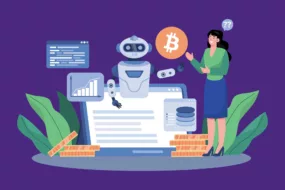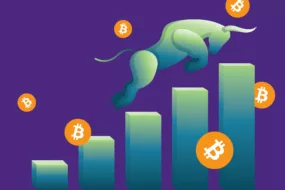
Have you heard of tokenization in the world of cryptocurrency? It has become an increasingly popular topic in the world of cryptocurrency. Tokenization involves turning real-world assets into digital tokens that can be traded on a blockchain network. This technology has the potential to change the way people buy, sell, and manage assets.
In this blog, we’re gonna dive into the world of tokenization in crypto. We’ll explore how it works, the benefits for investors and asset issuers, and some potential use cases. Plus, we’ll take a look at some of the challenges and limitations of the technology. Whether you’re a seasoned crypto investor or just starting out, this blog will give you a solid overview of one of the most exciting developments in the industry. So, let’s dive right in!
What Is Tokenization?
Tokenization refers to the process of converting real-world assets, such as art, real estate, or stocks, into digital tokens that can be traded on a blockchain network. These tokens are designed to represent ownership of the underlying asset and can be traded and tracked in a transparent and secure way.
The cool thing about tokenization is that it lets people own a fraction of an asset instead of having to buy the whole thing. This makes investing in things that are normally expensive or hard to trade more accessible to regular folks. Plus, using blockchain tech means that there’s less need for intermediaries, like brokers and lawyers, so that it can save people money and hassle. Thus, tokenization can improve transparency and reduce the costs associated with asset ownership and management.
How Does Tokenization Function?
Tokenization in crypto works by creating digital tokens that represent ownership of a real-world asset. Think art, real estate, or even stocks. And tokenization is typically done using a blockchain network, such as Ethereum or Binance Smart Chain.
Basically, tokenization involves taking the asset and turning it into smaller units that can be issued as tokens. Once the tokens have been created, they can be traded on a decentralized exchange (DEX) or other trading platforms. Investors can buy and sell the tokens in the same way they would trade any other cryptocurrency. The ownership of the tokens is tracked on the blockchain network, which provides a transparent and secure way to verify ownership and transfer ownership.
Tokenization is a win-win for investors and asset issuers. Investors get greater access to more assets and more liquidity, while asset issuers can raise funds and manage ownership of the asset more easily.
Types of Tokenization
The type of tokenization you use depends on what you’re trying to do and what kind of asset you’re dealing with. These are the main types of tokenization.
1. Asset-backed tokenization
Asset-backed tokenization is where you create tokens that represent ownership of an asset, like real estate, gold, or stocks. The tokens are backed by the value of the underlying asset, so their value is tied to the value of the asset. This can make it easier to buy and sell assets that are normally hard to trade, and it can potentially increase liquidity and trading volume by increasing the number of potential buyers and sellers.
2. Utility tokenization
Utility tokenization is where you create tokens that give you access to a specific product or service, like a blockchain-based platform or application. These tokens aren’t backed by any physical asset, but they’re used to do things like facilitate transactions or access certain features or benefits within the platform or app.
3. Security tokenization
There are also security tokens, which are like asset-backed tokens, but they represent ownership in a security, like stocks, bonds, or investment funds. These are subject to securities regulations and can give investors legal rights like voting rights or dividend payments.
4. Payment tokenization
This involves creating tokens that are used as a means of payment or exchange within a specific ecosystem or network, such as a stablecoin or other cryptocurrency that’s pegged to a specific currency or asset.
Advantages of Tokenization
Tokenization in crypto offers several advantages, including:
1. Increased liquidity
Tokenization can make it easier to buy and sell traditionally illiquid assets, such as real estate or artwork. By creating tokens that represent ownership of these assets, investors can buy and sell fractional ownership of the assets, which can increase liquidity and trading volume.
2. Improved efficiency
Tokenization can streamline the process of buying, selling, and managing assets, reducing the need for intermediaries like brokers and lawyers. By using blockchain technology, ownership of the asset can be easily verified and transferred, making the process more efficient and transparent.
3. Greater accessibility
Tokenization can provide greater access to a wider range of assets, making it easier for investors to diversify their portfolios and invest in assets that were previously out of reach. This is because tokenization creates digital representations of assets that can be bought and sold in smaller units, making it easier for investors to diversify their portfolios and invest in assets that were traditionally only available to high-net-worth individuals or institutional investors.
4. Enhanced security
Tokenization can improve the security of asset ownership and transfer by using blockchain technology to store and verify ownership of the tokens. This can reduce the risk of fraud and increase trust between buyers and sellers.
5. Lower costs
Tokenization can potentially lower the costs associated with buying, selling, and managing assets, as it can reduce the need for intermediaries such as brokers, lawyers, and other service providers and streamline the process.
Tokenization Examples
There are several real-world examples of tokenization that are in use today, including:
1. Real estate
Many companies are tokenizing real estate assets, allowing investors to buy and sell fractional ownership of properties. For example, a company called RealT is using tokenization to enable fractional ownership of rental properties in Detroit.
2. Artwork
Art investment platforms like Maecenas and ARTiFACTS are using tokenization to enable investment in high-end artwork. This allows investors to buy and sell fractional ownership of artworks and potentially benefit from any appreciation in value.
3. Securities
Several companies are tokenizing securities, including stocks and bonds. This makes it easier for investors to buy and sell fractional ownership. For example, a company called tZERO is using tokenization to trade securities on a blockchain-based platform.
4. Commodities
Several companies are using tokenization to enable investment in commodities like gold, silver, and oil. For example, a company called Digix is using tokenization to allow investors to buy and sell fractional ownership of gold.
5. Intellectual property
Some companies are exploring the use of tokenization for intellectual property, such as patents and copyrights. A company called IPwe is using tokenization to create a marketplace for buying and selling patents.
These are just a few examples of how tokenization is being used in the real world to enable new forms of investment and asset ownership. As the technology continues to evolve, it’s likely that we will see even more use cases for tokenization in the future.
Conclusion
Tokenization can make it easier for people to invest in a wide range of assets, from real estate to artwork and commodities, and potentially increase liquidity and accessibility. Of course, there are still some risks and challenges to navigate, as tokenization is still a relatively new technology. But, it offers a lot of potential benefits, like reducing costs and increasing efficiency.
Overall, it’s an exciting time for tokenization, and we can expect to see more innovation and growth in the use of this technology in the future. Just remember, if you’re interested in investing through tokenization, be sure to work with experienced professionals and do your due diligence. With the right approach, tokenization can offer a new level of accessibility and opportunity for investors.
FAQs
1. What is the tokenization system in India?
As of now, there is no specific tokenization system in India, but the Reserve Bank of India (RBI) has issued guidelines on tokenization of card transactions, which came into effect on October 1, 2022. These guidelines require consumers to create specific codes or substitute tokens instead of exposing real card information.
2. What is the future of tokenization?
The future of tokenization is very promising, and the technology is likely to continue to evolve and expand in the coming years. Potential developments include expansion to new asset classes like sports memorabilia, increased adoption in mainstream finance, integration with DeFi, etc. Of course, better regulations can greatly help with its adoption.
3. How safe is tokenization?
Tokenization is safe if it is implemented correctly and with appropriate security measures. Potential risks include hacking and regulatory risks. To mitigate these risks, it’s important to work with experienced professionals and take appropriate security measures, such as using a secure blockchain network, implementing multi-factor authentication, and keeping private keys secure.





